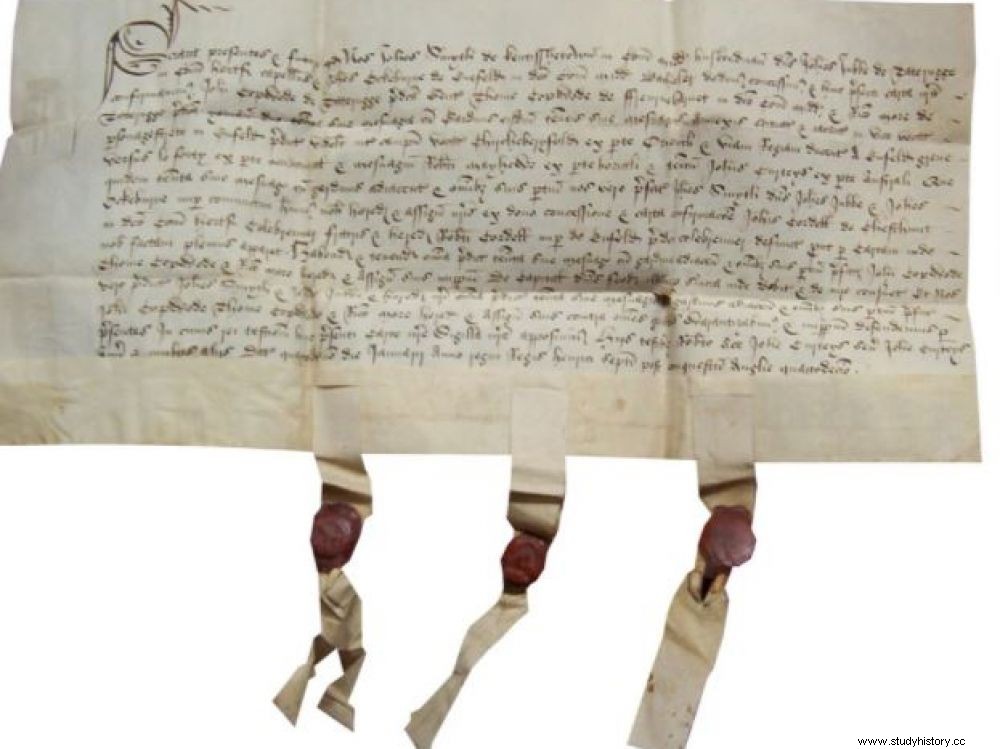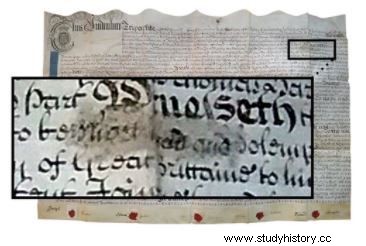In the Middle Ages, in some areas, sheepskin scrolls were preferred to those of other animal species to deter forgers.

Title deed to land at Enfield, Middlesex, signed and sealed January 1499, on sheepskin parchment.
Preventing the manipulation of documents by fraudsters by preserving the integrity of the texts:this has always been the problem for the authorities... and this since the 13th th century. This concern then concerned the deletion or modification of certain passages in legal and notarial acts (wills, deeds of property, etc . ). But the clerks, in charge of their drafting, had apparently found the solution! By prioritizing sheepskin scrolls, rather than those of other species like goat or calf (vellum). This is revealed by a study conducted on English, Scottish, Welsh and Irish legal archives, published in the journal Heritage Science . "The very structure of the sheepskin would have made attempts to fraudulently delete or modify the texts obvious" , conclude the work carried out on the parchments of the XVI th in the 19 th century, by researchers from the British universities of Exeter, York and Cambridge on the 645 samples analyzed (by protein identification by mass spectrometer), including 622 from sheep.
Calves, cows, sheep, goats...
 Visible erasure of a date on an 18
th century sheepskin parchment
century. ©Heritage Science.
Visible erasure of a date on an 18
th century sheepskin parchment
century. ©Heritage Science.
Sheep retain fat between the upper layers of the dermis. Sheep skins thus have a very high fat content (30 to 50% against 3 to 10% for goat skins and 3% for cattle). The preparation of the parchment for several weeks consisted in removing hair and flesh from the skins before plunging them into a bath of water and quicklime intended to remove the last impurities and degrade these fats. These baths attacked skin lipids. The skins were then stretched on trestles, the collagen fibers following a preferential direction depending on these tensions. However, sheepskins in the state of tanned skins have a particularity when they degrade:the leather grain can delaminate, go into a film, as if the skin was peeling.
Sheepskin scrolls "because they are not easily erased"
Result:"Any scraping of the inks resulted in the detachment of these films, leaving a visible stain, witnessing the slightest attempt at modification" , write the co-signers of the article. "Nevertheless, apart from any voluntary mechanical action, the phenomenon of delamination remains rare on parchment-lined sheepskin, that is to say limed and stretch-dried ", made a point of specifying Eric Laforet, restorer at the Atelier de restauration des Archives Nationales, in Paris, who did not participate in the study. "If the clerks of the time were concerned about the document authenticity and security , our study shows that it started with the choice of animal skins" , added the authors of the article.
A text from the twelfth th century confirms this. The Scaccario's Dialog , a document attributed to the Englishman Richard FitzNeal (1130-1189), Lord Treasurer during the reigns of Henry II and Richard I st , thus recommends the use of sheepskin scrolls for the keeping of royal accounts "because they do not readily yield to erasure without the defect being apparent" . To correct an error in an official record, a clerk would not strike out a text, but would strike it out and carry the correction in a clear line above. The abundance of sheepskins -especially in northern Europe- and their low cost must also have contributed to maintaining the choice of this type of parchment until the end of the 19 th century. This study confirms the rise of biocodicology – the molecular study of parchments – which brings overlooked insights into these often overlooked documents that are common legal documents produced by the hundreds of thousands over the centuries.
